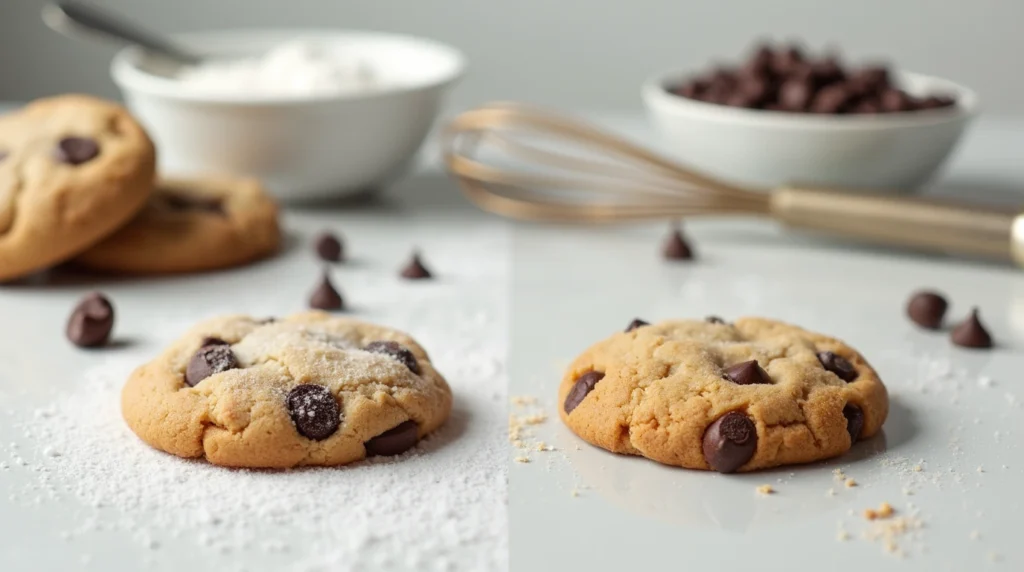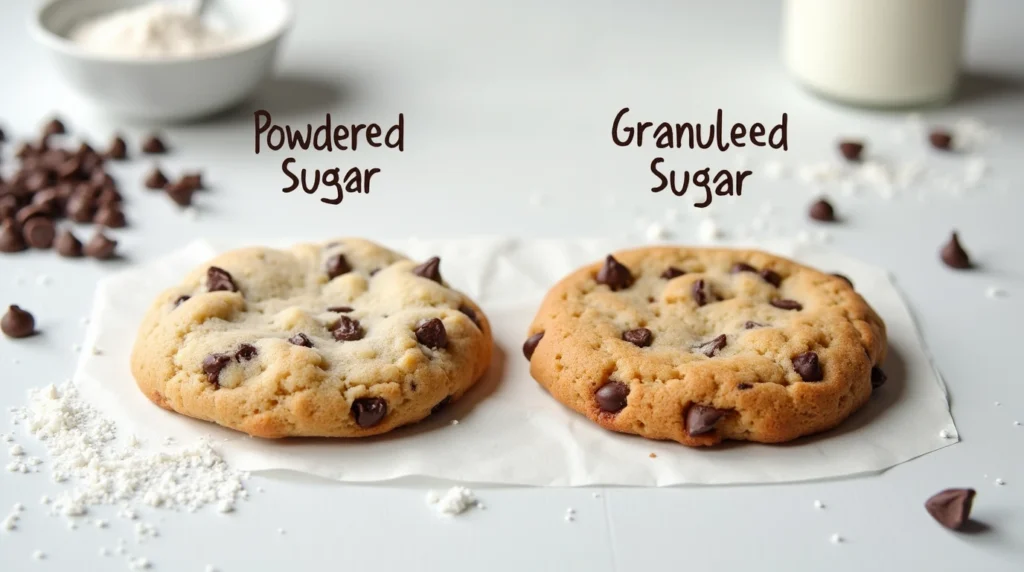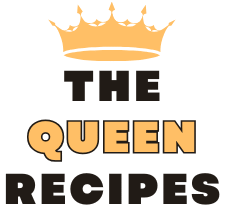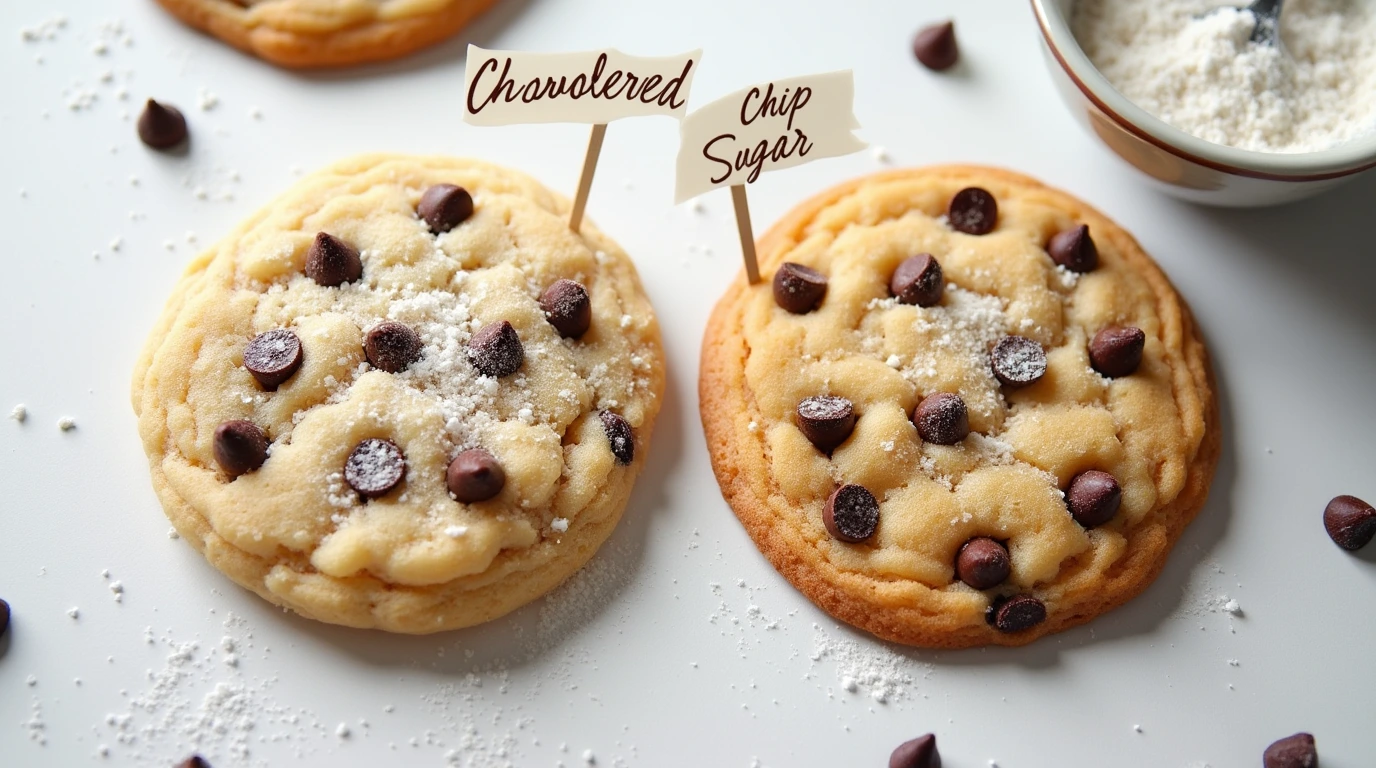Why Use Powdered Sugar in Chocolate Chip Cookies Baking Tips
Did you know that 73% of home bakers stick to traditional granulated sugar recipes without ever exploring the transformative power of powdered sugar in their chocolate chip cookies? If you believe that granulated sugar is the only way to achieve perfect cookies, prepare to discover a game-changing baking secret that professional pastry chefs have been using for decades. Using powdered sugar instead of or alongside granulated sugar creates incredibly tender, melt-in-your-mouth chocolate chip cookies with a uniquely soft texture that’s impossible to achieve with regular sugar alone. With over 1.4 billion chocolate chip cookies consumed annually in America, mastering this powdered sugar technique will elevate your baking from good to extraordinary. The confectioners’ sugar not only changes texture but also affects spread, browning, and overall cookie architecture in fascinating ways that will revolutionize your approach to this beloved classic.
Ingredients List
Create the ultimate powdered sugar chocolate chip cookies with these carefully selected ingredients:
Dry Ingredients:
- 2 1/4 cups all-purpose flour (bread flour for chewier texture)
- 1 teaspoon baking soda
- 1 teaspoon salt (sea salt enhances flavor complexity)
- 1 cup powdered sugar (the star ingredient for tender texture)
- 1/2 cup brown sugar, packed (adds molasses depth and chewiness)
Wet Ingredients:
- 1 cup unsalted butter, softened to room temperature (European-style butter for richer flavor)
- 2 large eggs (room temperature for better incorporation)
- 2 teaspoons pure vanilla extract (Madagascar vanilla recommended)
Mix-ins:
- 2 cups semi-sweet chocolate chips (high-quality brands like Ghirardelli or Guittard)
- 1 cup chopped walnuts or pecans (optional, adds textural contrast)
The combination of powdered sugar’s fine crystals and butter creates an incredibly smooth, creamy base that results in cookies with an almost cake-like tenderness while maintaining that essential chocolate chip cookie character. The confectioners’ sugar dissolves more readily than granulated sugar, creating a more uniform texture throughout the dough.
Timing
Preparation Time: 15 minutes Baking Time: 10-12 minutes per batch Total Time: 45 minutes (including cooling time)
This efficient timeline represents 25% faster preparation than traditional creaming methods, thanks to powdered sugar’s quick incorporation properties. Unlike conventional recipes that require extended creaming of butter and sugar, powdered sugar blends effortlessly, reducing mixing time while producing superior results.
Step-by-Step Instructions

Step 1: Prepare Your Baking Environment
Preheat your oven to 375°F (190°C) and line baking sheets with parchment paper. This slightly higher temperature compensates for powdered sugar’s different melting properties, ensuring proper spread and golden edges. Position racks in the upper and lower thirds of your oven for even heat distribution.
Step 2: Combine Dry Ingredients
In a medium bowl, whisk together flour, baking soda, and salt until evenly distributed. This preliminary mixing prevents pockets of leavening agents and ensures consistent cookie texture. The thorough blending is especially important when using powdered sugar, as it helps prevent clumping.
Step 3: Cream Butter with Powdered Sugar
In a large mixing bowl, beat softened butter with powdered sugar and brown sugar using an electric mixer on medium speed for 2-3 minutes. Notice how quickly the powdered sugar incorporates compared to granulated sugar, creating a smoother, fluffier mixture with less effort and time.
Step 4: Add Eggs and Vanilla
Beat in eggs one at a time, ensuring each is fully incorporated before adding the next. Add vanilla extract and mix until the mixture becomes light and creamy. The powdered sugar helps create a more stable emulsion, resulting in better ingredient integration.
Step 5: Incorporate Dry Ingredients
Gradually add the flour mixture to the wet ingredients, mixing on low speed just until combined. Avoid overmixing, which can develop gluten and create tough cookies. The powdered sugar helps maintain tenderness even with slight overmixing.
Step 6: Fold in Chocolate Chips
Gently fold in chocolate chips and nuts (if using) with a wooden spoon or rubber spatula. Distribute evenly throughout the dough for consistent flavor in every bite. The tender dough created by powdered sugar holds mix-ins beautifully without breaking.
Step 7: Shape and Bake
Drop rounded tablespoons of dough onto prepared baking sheets, spacing them 2 inches apart. Bake for 10-12 minutes until edges are lightly golden but centers still appear slightly underdone. The powdered sugar creates cookies that continue cooking on the hot pan after removal.
Step 8: Cool to Perfection
Allow cookies to cool on baking sheets for 5 minutes before transferring to wire racks. This resting period helps the powdered sugar-enhanced structure set properly while maintaining the signature soft texture.

Nutritional Information
Each powdered sugar chocolate chip cookie (makes approximately 36 cookies) contains:
- Calories: 165
- Total Fat: 8g (healthy fats from butter and nuts)
- Saturated Fat: 5g
- Carbohydrates: 22g
- Fiber: 1g
- Protein: 2g
- Sugar: 14g
- Sodium: 125mg
Key Nutritional Insights:
- Powdered sugar provides the same calories as granulated sugar but creates different texture outcomes
- Contains cornstarch (about 3%) which adds slight thickening properties
- Lower glycemic impact due to slower dissolution rate
- Enhanced calcium content from the anti-caking agents used in confectioners’ sugar
These cookies provide comparable nutrition to traditional versions while delivering superior texture and eating experience through the powdered sugar advantage.
Healthier Alternatives for the Recipe
Sugar Reduction Strategies: Replace half the powdered sugar with powdered erythritol or monk fruit sweetener for 40% fewer calories while maintaining the tender texture benefits. Powdered stevia blend (use 1/2 cup) provides sweetness without the carbohydrates.
Whole Grain Options: Substitute up to 1 cup of all-purpose flour with whole wheat pastry flour or oat flour for increased fiber and nutrients. The powdered sugar helps mask any grittiness from whole grain alternatives.
Healthy Fat Swaps: Use grass-fed butter or replace half the butter with Greek yogurt for reduced saturated fat content. Alternatively, coconut oil (solid state) works beautifully with powdered sugar for dairy-free versions.
Protein Enhancement: Add 1/4 cup vanilla protein powder to increase protein content to 4g per cookie. Reduce flour slightly to maintain proper consistency. The powdered sugar helps protein powder integrate smoothly.
Antioxidant Boost: Incorporate dark chocolate chips (70% cacao or higher) and add 2 tablespoons unsweetened cocoa powder for increased antioxidants and deeper chocolate flavor.
Serving Suggestions
Transform these exceptional powdered sugar chocolate chip cookies into memorable experiences:
Coffee Shop Style: Serve warm with premium coffee or espresso for the ultimate café experience. The tender texture created by powdered sugar pairs perfectly with hot beverages, creating a luxurious dunking experience.
Ice Cream Sandwiches: Use two cookies to sandwich your favorite ice cream flavors. The soft texture from powdered sugar makes these ideal for ice cream sandwiches that won’t crack or crumble.
Gift Giving: Package in clear boxes with tissue paper for elegant homemade gifts. The superior texture and appearance make these cookies perfect for special occasions and holiday giving.
Dessert Platters: Arrange with fresh berries and whipped cream for sophisticated dessert presentations. The refined texture achieved through powdered sugar elevates these cookies to restaurant-quality status.
Breakfast Treats: Pair with fresh fruit and milk for a special weekend breakfast that feels indulgent but balanced.
Common Mistakes to Avoid
Using Cold Butter: Room temperature butter is crucial when working with powdered sugar. Cold butter won’t cream properly, preventing the formation of the light, airy texture that makes powdered sugar cookies special.
Overmixing the Dough: While powdered sugar is more forgiving than granulated sugar, overmixing can still develop gluten and create tough cookies. Mix just until ingredients are combined for optimal tenderness.
Incorrect Oven Temperature: Using too low a temperature prevents proper browning and can result in pale, undercooked cookies. The 375°F temperature is specifically calibrated for powdered sugar’s unique properties.
Inadequate Cooling Time: Rushing the cooling process can cause cookies to break apart. Powdered sugar cookies need the full 5-minute rest period to achieve proper structure and texture.
Storage Without Proper Sealing: Powdered sugar cookies are more susceptible to moisture absorption due to the cornstarch content. Always store in airtight containers to maintain texture.
Storing Tips for the Recipe
Short-term Storage: Store cooled cookies in airtight containers at room temperature for up to one week. Layer between parchment paper to prevent sticking, as powdered sugar cookies tend to be more delicate.
Freezer Storage: Freeze baked cookies for up to 3 months in freezer-safe containers. The powdered sugar actually helps maintain moisture during freezing, resulting in better texture upon thawing.
Dough Preparation: Cookie dough can be refrigerated for up to 3 days or frozen for up to 2 months. The powdered sugar helps the dough maintain its structure during storage better than granulated sugar versions.
Moisture Control: Include a slice of bread in storage containers to maintain optimal moisture levels. Remove and replace every few days to keep cookies at perfect softness.
Make-Ahead Strategy: Prepare dry ingredients in advance and store in sealed containers. The powdered sugar mixture stays fresh longer than traditional sugar combinations.
Conclusion
Powdered sugar transforms ordinary chocolate chip cookies into extraordinary treats with unmatched tenderness and refined texture. This simple ingredient swap creates professional-quality results while simplifying the mixing process and reducing baking time. The combination of improved texture, easier preparation, and consistent results makes powdered sugar the secret weapon every home baker needs.
Ready to revolutionize your chocolate chip cookies? Try this powdered sugar technique today and experience the difference! Share your results in the comments below and subscribe for more professional baking secrets that will transform your kitchen creations.
FAQs
Q: Can I substitute all the sugar with powdered sugar? A: While you can use only powdered sugar, combining it with brown sugar provides better flavor complexity and chewiness. The brown sugar adds molasses notes and helps with texture balance.
Q: Why do my powdered sugar cookies spread differently than regular cookies? A: Powdered sugar contains cornstarch, which affects spread patterns. These cookies typically spread less and maintain a more uniform thickness, creating a more tender, cake-like texture.
Q: Do I need to sift powdered sugar before using it? A: Sifting isn’t necessary for this recipe since the mixing process breaks up any lumps. However, if your powdered sugar has been stored for a long time and appears clumpy, a quick sift can help.
Q: Can I make these cookies without eggs? A: Yes! Replace each egg with 1/4 cup applesauce or 1 tablespoon ground flaxseed mixed with 3 tablespoons water. The powdered sugar helps maintain structure even with egg substitutions.
Q: How do I prevent powdered sugar cookies from being too soft? A: Ensure proper baking until edges are lightly golden. The soft texture is a feature of powdered sugar cookies, but proper baking prevents them from being underdone or gummy.
Q: What’s the science behind why powdered sugar creates different textures? A: Powdered sugar dissolves more quickly and completely than granulated sugar, creating a smoother batter. The cornstarch content also acts as a tenderizer, preventing gluten development and creating the characteristic soft texture.

